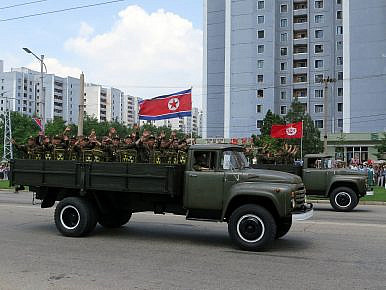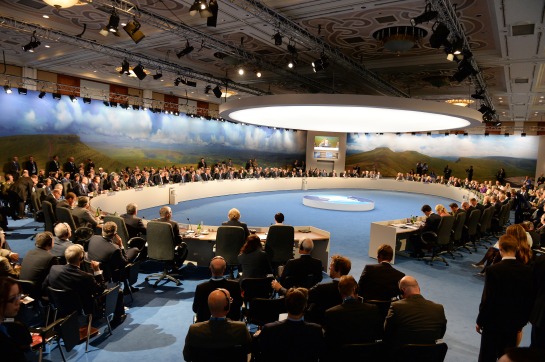International Relations and Security Network, 30 October, 2014 
Japan and Russia have been engaged in a diplomatic cat-and-mouse game for many years now. The latest round of events saw Russian President Vladimir Putin and Japanese Prime Minister Shinzo Abe meet briefly on the sidelines of the Asia-Europe Meeting (ASEM) in Milan, with the two agreeing to continue their discussions at the APEC Summit in November. For both men, however, the stakes of this game are rising. Japan needs to diversify its energy supplies following the post-Fukushima nuclear shut-down, and building an energy relationship with Moscow would offset growing Chinese dominance of the continent. For Russia, the stakes are equally high: Putin shares Abe’s desire to balance against growing Chinese continental strength and wants to carry out his own ‘pivot’ to East Asia and the Arctic. He aims to do this through a combination of smart diplomacy with powers like Vietnam and Japan, and by shifting Russia’s energy focus from the stagnant European market to the growing Asian one. He also plans to economically develop Russia’s East and gradually restore its military power in the region. But despite these high stakes and compatible interests, closer ties between the two countries remain hobbled by uncertainly over one issue in particular: the future of the disputed Kuril Islands. Tokyo would like to regain its lost “Northern Territories,” seized by Stalin immediately after the Second World War, but it is unclear whether Moscow is willing to make a deal.
Foreign policy matches
By any account, Putin’s foreign policy has been in shambles since last year’s successful chemical weapons deal protecting the Assad regime. Since then, Russia has become increasingly isolated and marginalized diplomatically, first over anti-homosexual legislation, and then over Ukraine. The unexpected fall of key ally Victor Yanukovych in the 2014 Ukrainian Revolution precipitated a conflict on his doorstep and provoked an impulsive decision to secure Russian naval interests in the Crimea by force. The decision to annex the Crimea, while popular at home, has come at a great price, wiping out decades of good-will in Europe and the United States. Putin, however, does not seem to mind Russia’s isolation, which puts him in good company with the Japanese Prime Minister. Under Abe’s leadership, Japan has become similarly isolated in Northeast Asia, where Abe’s nationalist leanings have offended the Koreas, China, and even the US. Despite long-standing institutional closeness within the US-Japan alliance, Abe’s nationalism has caused some frostiness between him and the White House, with his decision to visit the controversial Yasukuni Shrine last year drawing a rare rebuke from Washington.
Until a few years ago, discussions between Moscow and Tokyo were dominated by the territorial issue and by a long-discussed proposal for a gas-pipeline or LNG deal to supply Japanese and South Korean energy needs. These two states are the two largest LNG importers, and would represent a sizable catch for Putin if he can land them. James Byrne, an energy consultant at the Tokyo-based Mathyos Energy states: “Faced with declining demand in Europe, Russia and Gazprom must break into new markets in China, Japan and South Korea. The recent pipeline deal with China forms the backbone of a much larger planned far-eastern supply network that includes an LNG plant that would supply Japan. Also under consideration is a large-diameter gas pipeline.” According to Interfax, as Putin was pushing through the agreement to annex the Crimea through the Russian parliament, Igor Sechin – a Rosneft official close to Putin – was simultaneously in Tokyo offering Japan sizable concessions at a Russia-Japan Investment Forum, saying that Russia was “prepared to offer the most extensive opportunities for cooperating in meeting potential demand” as well as offset opportunities in shipbuilding.
Despite the domestic debate in Japan over the energy deal and concerns about crossing Washington over Crimea, Abe sees the current situation as a potential opportunity to gain concessions. On the one hand, he has followed the West in imposing sanctions on Moscow and promised US$1.5 billion in aid to the new Ukraine government. But, on the other, he met with Putin five times in the 18 months prior to Ukraine and initiated a 2+2 meeting (featuring the defense and foreign ministers of both countries). If he can sweeten the pipeline negotiations with a deal on the islands, he will make his mark on Japanese politics as a historical leader: after all, the issue has become a perennial one for Japanese Prime Ministers, with Hatoyama, Kan, Aso and now Abe all pushing to be the man who brings the islands back into the fold.
The Great Game: Northeast Asian style
Close observers of Abe have noted that the Japanese Prime Minister is interested in more than just energy and the islands. Indeed, he has a far more complex foreign policy towards Moscow than previous Japanese leaders, which contains a personal element: his father Shintaro Abe was instrumental in improving Russo-Japanese ties in the early 1990s and had a close relationship with former Soviet leader Mikhail Gorbachev. As his father’s secretary and aide, Abe’s formative political years were spent working on ties with Russia. Because of this relationship, Abe sees the bilateral with Moscow as crucial in the growing geopolitical contest for Northeast Asia. In April 2013, he met Putin in Moscow and signed a memorandum of cooperation on a number of different projects, including joint development of the Magadan oil and gas field under the Sea of Okhotsk, an agreement for Rosneft to sell 1 million metric tons of LNG annually to SODECO, 1.25 million metric tons to Marubeni, and to establish a joint LNG plant in Vladivostok.
Of course, all of this pales in comparison to the US$400 billion deal between Moscow and Beijing in May of this year, a deal that shook energy markets. Although the deal promises to bring down LNG prices across Asia, the formation of a Sino-Russian bloc would be a disaster for Japan, given its close proximity to the borders of both. It has territorial disputes with both states, and cannot risk having them coordinate their efforts.
What would you give for an island?
It is difficult to know whether Moscow would be willing to make a deal on the island. Putin has offered a compromise in which Russia would keep two of the larger islands and give two of the smaller ones to Japan, but no Japanese leader has favored such a deal. Instead, many inside Kasumigaseki – Japan’s equivalent of Whitehall – believe that Russia’s estrangement from the West bodes well for Japan’s chances of regaining all four islands. Despite Abe’s careful maneuvering, however, it is not clear what President Putin intends to do. On the one hand, Putin needs Japanese investment, technology and energy cooperation; on the other, he knows that Japan needs to buy his LNG as much as he needs to sell it. Talk of an American shale revolution exporting to the Asia market has yet to materialize, and Japan needs energy in the meantime. Putin is also keen to fight Washington’s efforts to isolate him. A deal with Japan, a close American ally, might drive a wedge between the two and serve his East Asian foreign policy push.
But while many argue that Putin is a pragmatist before he is a nationalist, he may still be unwilling to give up Russian territory for two reasons in particular: first, the mood of the country is against it, and second – in a real twist of fate – many of the 30,000 inhabitants of the islands emigrated from the Ukraine during the Cold War. Moving them forcibly would present him with grave domestic challenges, to say the least. As it stands, Russia has already carried out a US$630 million policy of investment into the islands, and expanded its military presence there. Russia, therefore, may continue to dangle the islands in front of Japan, and Japan will continue to play for them. Although neither country quite believes in a deal, neither is quite willing to give one up. It will be interesting to see how this odd game of cat and mouse plays out.







